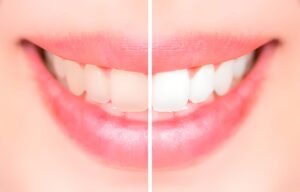Composite bonding is a popular cosmetic dental treatment. It helps improve the shape, colour, or size of your teeth. Many people choose it to fix chipped teeth or close small gaps. But one common question is: Can you bite into an apple with composite bonding? Let’s break it down in simple words so you can understand exactly what to expect.
What Is Composite Bonding?
Composite bonding uses a special material that matches your tooth colour. This material is applied to the surface of your tooth and shaped to look natural. The dentist then hardens it using a special light. It’s quick, painless, and usually done in one visit. Best Composite bonding is often used to: repair chips or cracks, close small gaps, improve tooth shape, and cover discolouration. It is an affordable way to get a better smile.
How Long Does Composite Bonding Usually Last?
Is Composite Bonding Strong?
Yes, composite bonding is strong. But it’s not as tough as your natural teeth or materials like crowns. So, while it can handle normal chewing, it’s not built for biting into very hard things. If you use your bonded teeth to bite into hard foods or objects, it can chip or wear down the bonding material.
Can I Bite into an Apple?
The short answer is: Yes, but be careful. If your bonding was done on your front teeth, you should avoid biting directly into very hard apples. Instead, cut the apple into slices and chew using your back teeth. This keeps the bonding safe and long-lasting. If the bonding is on your back teeth or on teeth that don’t do the biting, you can eat apples like normal.
What Foods Should I Be Careful With?
Composite bonding isn’t as hard as natural enamel. So, it’s best to avoid or be gentle with: crunchy fruits like apples or raw carrots, hard bread or crusty pizza, sticky sweets like toffees, and nuts or ice cubes. It’s not about avoiding these foods completely. It’s just about not putting too much pressure on the bonded tooth.
Aberdeen Composite Bonding 101: What Is It and How Does It Work?
How Long Does Composite Bonding Last?
With good care, composite bonding can last between 3 to 7 years. But it depends on: how well you look after your teeth, if you avoid hard or sticky foods, if you grind your teeth, and whether you visit your dentist for check-ups. Small chips or stains can be fixed easily, so don’t worry if something does happen.
Tips to Protect Your Bonding
Here are some simple ways to make your bonding last longer: brush twice a day with a soft toothbrush, avoid smoking or drinking too much coffee or red wine, as these can stain the bonding, wear a mouthguard if you grind your teeth at night, don’t use your teeth to open things like bottles or packets, and visit your dentist regularly to check on your bonding. These habits not only protect your bonding but also help keep your whole mouth healthy.
What If It Chips?
If your bonding chips, don’t panic. It can be fixed quickly. Just book an appointment with your dentist. They will reapply or reshape the material so it looks as good as new. The sooner you go, the easier the fix will be.
Can Composite Bonding Correct Crooked Teeth?
Should I Get Composite Bonding?
If you want to improve your smile without major treatment, composite bonding might be right for you. It’s quick, painless, and less costly than veneers or crowns. But it’s important to talk to your dentist first. They will check your teeth and tell you if bonding is the best option for you.
Final Thoughts
So, can you bite into an apple with composite bonding? Yes, you can. But it’s better to cut the apple into slices and chew with your back teeth. This helps protect the bonding from damage and keeps your smile looking great for longer. Professional Composite Bonding Aberdeen offers a simple and effective way to boost your confidence. With a little care, it can last for years and keep your teeth looking beautiful.
Book your consultation today!
Smile with Confidence at Bridge St Aesthetic and Dental Implant Clinic
If you’re considering composite bonding, we’re here to help. At Bridge St Aesthetic and Dental Implant Clinic, our skilled team offers high-quality, natural-looking results tailored to your smile. We take time to understand your goals and deliver treatments that feel just right for you. Whether you’re fixing a chipped tooth or refreshing your smile, we’ll guide you through every step with care.
📞 Book your consultation today and discover the difference a confident smile can make. Let’s create something beautiful—together.
How Much Is Composite Bonding?
Frequently Asked Questions
Does composite bonding require drilling or anaesthesia?
No, composite bonding usually doesn’t require drilling or anaesthesia. The material is applied directly to the tooth surface, shaped, and hardened with a special light. It’s a non-invasive and comfortable procedure that many patients complete in just one visit.
How soon can I eat after getting composite bonding?
You can eat soon after the bonding is done, as the material is fully hardened during the procedure. However, it’s best to wait a couple of hours and start with soft foods to avoid any immediate pressure on the treated tooth.
Will my bonded tooth look different from the others?
No, the bonding material is colour-matched to your natural teeth. Skilled dentists shape and polish it carefully, so it blends in perfectly. Most people won’t be able to tell the difference between a bonded tooth and your natural ones.
Can composite bonding be whitened later?
No, composite bonding doesn’t respond to whitening treatments like natural teeth. If you’re planning to whiten your teeth, it’s best to do that first. The bonding can then be matched to your brighter tooth shade for a more even appearance.
Is composite bonding covered by dental insurance?
It depends on your insurance policy. Since composite bonding is often considered cosmetic, many plans may not cover it. However, if it’s for tooth repair due to damage, some providers might offer partial coverage. It’s best to check with your insurer first.
How Much Does Composite Bonding Cost Per Tooth in the UK?





